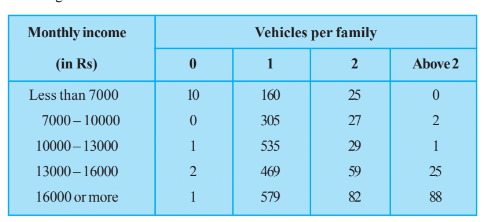Select the common characters between solanaceae and liliaceae families. a. placentation in ovary b. persistent calyx c. number of stamens d. superior ovary e. endospermous seed
a, c & d
a, d & e
c, d & e
a, b & e
Step by step video & image solution for Select the common characters between solanaceae and liliaceae families. a. placentation in ovary b. persistent calyx c. number of stamens d. superior ovary e. endospermous seed by Biology experts to help you in doubts & scoring excellent marks in Class 12 exams.
Updated on:21/07/2023Topper's Solved these Questions
Similar Questions
An organization selected 2400 families at random and surveyed them to determine a relationship between income level and the number of vehicles in a family. The information gathered is listed in the table below:

Suppose a family is chosen. Find the probability that the family chosen is (i) earning Rs 10000 – 13000 per month and owning exactly 2 vehicles. (ii) earning Rs 16000 or more per month and owning exactly 1 vehicle. (iii) earning less than Rs 7000 per month and does not own any vehicle. (iv) earning Rs 13000 – 16000 per month and owning more than 2 vehicles. (v) owning not more than 1 vehicle
View Solutionhree students described the floral characters of a plant belonging to family Liliaceae. One of them described correctly and the others two were wrong. Who was correct and which characters were described wrong by the other two ?
Student A : Tetramerous, actinomorphic, polyphyllus, unilocular ovary, axile placentation.
Student B : Trimerous, actinomorphic, polyandrous, superior ovary, axile placentation
Student C : Trimerous, zygomorphic, gamophyllus, inferior ovary, marginal placentation.
View Solution
Knowledge Check
Which of the following are characteristic features of solanceae
(a) Exstipulate leaves
(b) Persistent calytx
(c) Racemose inflorescence
(d) Unilocular ovary
(e) Fruits are either berry or capsule.
Of theseAa, b and e are correctBa, c and d are correctCa only is correctDd and e are correct.Consider the following characters with respect to gynoecium of Fabaceae and choose the correct options
(a) Ovary monocarpellary
(b) Many styles
(c) Placenta swollen
(d) Superior ovaryn
(e) Axile placentationAa, d and e onlyBd and e onlyCa and b onlyDa and d onlyThe main steps of plant breeding programmes is given below
(A) Cross hybridisation among the selected parents
(B) Testing release and commericialisation of new cultivars
(C ) Collection of variability
(D) Selection and testing of superior recombinants
(E ) Evalution and selection of parents
Arrange above steps in a systemetic wayAE→C→A→B→DBC→E→A→B→DCC→E→A→D→BDE→C→A→D→B
Select the characters which are not applicable to the family solanaceae
(i) Empipetalous and syngenesious anthers
(ii) Bicarpellary and syncarpous ovary
(iii) Oblique ovary with axile placentation
(iv) Stamens six, arranged in two whorls
(V) Bicarpellary, syncarpous and inferior ovary
View SolutionFlowers of Mustard resemble Makoi in
I) Number of Stamens
II) Number of Carpels
III) Placentation
IV) Superior ovary
View SolutionThese floral characters are of a specific family . Identify the plant which shows the following characters.
1 . Flower-bisexual , zygomorphic
2. Corolla - vexillary aestivation
3. Androecium - diadelphous
4. Gynoecium - ovary superior
5. Seed-Non-endospermic
View SolutionFind out the False statement from below ones-
(i)Calyx and corolla are reproductive organs of a flower.
(ii) Zygomorphic flower can be divided into two equal radial halves in any radial plane.
(iii) Flowers without bracts are termed as bracteate.
(iv)Parthenocarpic fruit is formed after fertilization of the ovary.
(v) In legumes seed is non-endospermic.
(vi) Ovary is inferior in Fabaceae. ---
(vii)A fertile stamen is called staminode.
(viii) Radical buds develop on roots.
View SolutionRead the following statements and find out the incorrect statement.
a. Mustard has hypogynous, actinomorphic flower, parietal placentation, syncarpous gynoecium and belongs to family Brassicaceae
b. China rose has superior ovary, twisted aestivation, monodephous stamens and axile placentation
c. Pea has bilateral symmetry, vexillary aestivation, diadelphous stamens, marginal placentation and belongs to family fabaceae
d. Chilli has radial symmetry, epipetalous stamen, swollen placenta, monocarpellary gynoecium and belongs to family solanaceae
e. Lily has actinomorphic flower, axile placentation, imbricate aestivation, tricarpellary and trilocular gynoeciom belonging to family liliaceae.
View Solution
